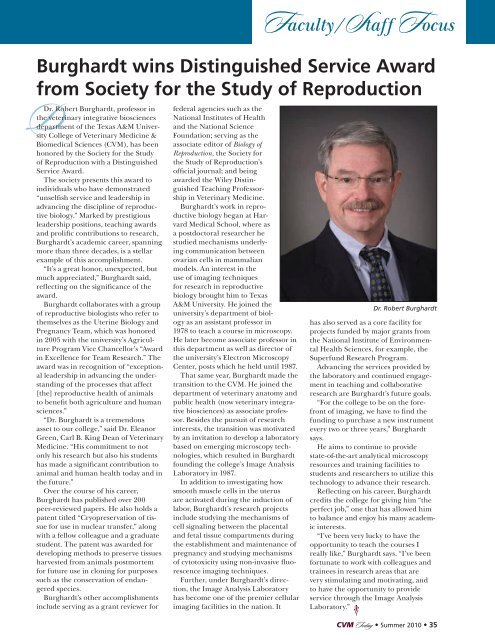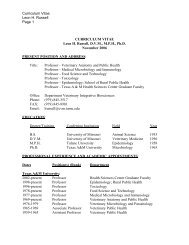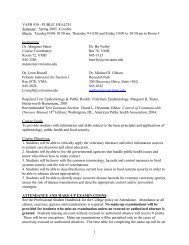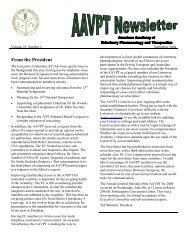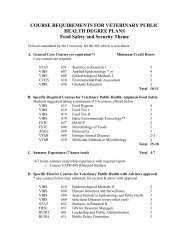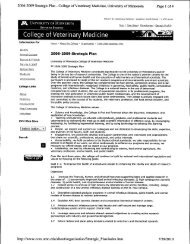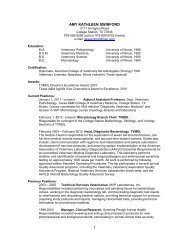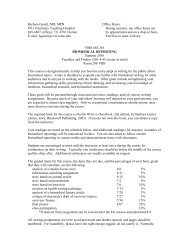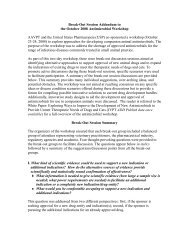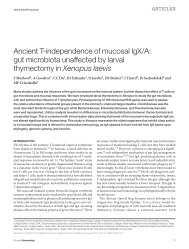Disaster - College of Veterinary Medicine - Texas A&M University
Disaster - College of Veterinary Medicine - Texas A&M University
Disaster - College of Veterinary Medicine - Texas A&M University
You also want an ePaper? Increase the reach of your titles
YUMPU automatically turns print PDFs into web optimized ePapers that Google loves.
Faculty/Staff Focus<br />
Burghardt wins Distinguished Service Award<br />
from Society for the Study <strong>of</strong> Reproduction<br />
Dr. Robert Burghardt, pr<strong>of</strong>essor in<br />
the veterinary integrative biosciences<br />
department <strong>of</strong> the <strong>Texas</strong> A&M <strong>University</strong><br />
<strong>College</strong> <strong>of</strong> <strong>Veterinary</strong> <strong>Medicine</strong> &<br />
Biomedical Sciences (CVM), has been<br />
honored by the Society for the Study<br />
<strong>of</strong> Reproduction with a Distinguished<br />
Service Award.<br />
The society presents this award to<br />
individuals who have demonstrated<br />
“unselfish service and leadership in<br />
advancing the discipline <strong>of</strong> reproductive<br />
biology.” Marked by prestigious<br />
leadership positions, teaching awards<br />
and prolific contributions to research,<br />
Burghardt’s academic career, spanning<br />
more than three decades, is a stellar<br />
example <strong>of</strong> this accomplishment.<br />
“It’s a great honor, unexpected, but<br />
much appreciated,” Burghardt said,<br />
reflecting on the significance <strong>of</strong> the<br />
award.<br />
Burghardt collaborates with a group<br />
<strong>of</strong> reproductive biologists who refer to<br />
themselves as the Uterine Biology and<br />
Pregnancy Team, which was honored<br />
in 2005 with the university’s Agriculture<br />
Program Vice Chancellor’s “Award<br />
in Excellence for Team Research.” The<br />
award was in recognition <strong>of</strong> “exceptional<br />
leadership in advancing the understanding<br />
<strong>of</strong> the processes that affect<br />
[the] reproductive health <strong>of</strong> animals<br />
to benefit both agriculture and human<br />
sciences.”<br />
“Dr. Burghardt is a tremendous<br />
asset to our college,” said Dr. Eleanor<br />
Green, Carl B. King Dean <strong>of</strong> <strong>Veterinary</strong><br />
<strong>Medicine</strong>. “His commitment to not<br />
only his research but also his students<br />
has made a significant contribution to<br />
animal and human health today and in<br />
the future.”<br />
Over the course <strong>of</strong> his career,<br />
Burghardt has published over 200<br />
peer-reviewed papers. He also holds a<br />
patent titled “Cryopreservation <strong>of</strong> tissue<br />
for use in nuclear transfer,” along<br />
with a fellow colleague and a graduate<br />
student. The patent was awarded for<br />
developing methods to preserve tissues<br />
harvested from animals postmortem<br />
for future use in cloning for purposes<br />
such as the conservation <strong>of</strong> endangered<br />
species.<br />
Burghardt’s other accomplishments<br />
include serving as a grant reviewer for<br />
federal agencies such as the<br />
National Institutes <strong>of</strong> Health<br />
and the National Science<br />
Foundation; serving as the<br />
associate editor <strong>of</strong> Biology <strong>of</strong><br />
Reproduction, the Society for<br />
the Study <strong>of</strong> Reproduction’s<br />
<strong>of</strong>ficial journal; and being<br />
awarded the Wiley Distinguished<br />
Teaching Pr<strong>of</strong>essorship<br />
in <strong>Veterinary</strong> <strong>Medicine</strong>.<br />
Burghardt’s work in reproductive<br />
biology began at Harvard<br />
Medical School, where as<br />
a postdoctoral researcher he<br />
studied mechanisms underlying<br />
communication between<br />
ovarian cells in mammalian<br />
models. An interest in the<br />
use <strong>of</strong> imaging techniques<br />
for research in reproductive<br />
biology brought him to <strong>Texas</strong><br />
A&M <strong>University</strong>. He joined the<br />
university’s department <strong>of</strong> biology<br />
as an assistant pr<strong>of</strong>essor in<br />
1978 to teach a course in microscopy.<br />
He later become associate pr<strong>of</strong>essor in<br />
this department as well as director <strong>of</strong><br />
the university’s Electron Microscopy<br />
Center, posts which he held until 1987.<br />
That same year, Burghardt made the<br />
transition to the CVM. He joined the<br />
department <strong>of</strong> veterinary anatomy and<br />
public health (now veterinary integrative<br />
biosciences) as associate pr<strong>of</strong>essor.<br />
Besides the pursuit <strong>of</strong> research<br />
interests, the transition was motivated<br />
by an invitation to develop a laboratory<br />
based on emerging microscopy technologies,<br />
which resulted in Burghardt<br />
founding the college’s Image Analysis<br />
Laboratory in 1987.<br />
In addition to investigating how<br />
smooth muscle cells in the uterus<br />
are activated during the induction <strong>of</strong><br />
labor, Burghardt’s research projects<br />
include studying the mechanisms <strong>of</strong><br />
cell signaling between the placental<br />
and fetal tissue compartments during<br />
the establishment and maintenance <strong>of</strong><br />
pregnancy and studying mechanisms<br />
<strong>of</strong> cytotoxicity using non-invasive fluorescence<br />
imaging techniques.<br />
Further, under Burghardt’s direction,<br />
the Image Analysis Laboratory<br />
has become one <strong>of</strong> the premier cellular<br />
imaging facilities in the nation. It<br />
Dr. Robert Burghardt<br />
has also served as a core facility for<br />
projects funded by major grants from<br />
the National Institute <strong>of</strong> Environmental<br />
Health Sciences, for example, the<br />
Superfund Research Program.<br />
Advancing the services provided by<br />
the laboratory and continued engagement<br />
in teaching and collaborative<br />
research are Burghardt’s future goals.<br />
“For the college to be on the forefront<br />
<strong>of</strong> imaging, we have to find the<br />
funding to purchase a new instrument<br />
every two or three years,” Burghardt<br />
says.<br />
He aims to continue to provide<br />
state-<strong>of</strong>-the-art analytical microscopy<br />
resources and training facilities to<br />
students and researchers to utilize this<br />
technology to advance their research.<br />
Reflecting on his career, Burghardt<br />
credits the college for giving him “the<br />
perfect job,” one that has allowed him<br />
to balance and enjoy his many academic<br />
interests.<br />
“I’ve been very lucky to have the<br />
opportunity to teach the courses I<br />
really like,” Burghardt says. “I’ve been<br />
fortunate to work with colleagues and<br />
trainees in research areas that are<br />
very stimulating and motivating, and<br />
to have the opportunity to provide<br />
service through the Image Analysis<br />
Laboratory.”<br />
CVM Today • Summer 2010 • 35


